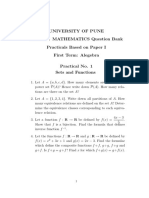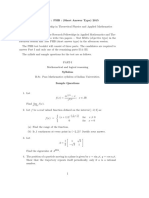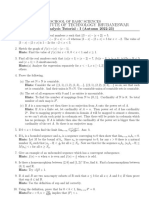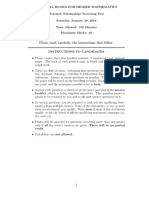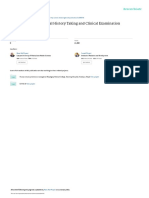Tutorials Maths
Uploaded by
saraaanshTutorials Maths
Uploaded by
saraaanshAssignment 1 : Real Numbers, Sequences
1. Let A be a non-empty subset of R and R. Show that = supA if and only if
1
n
is
not an upper bound of A but +
1
n
is an upper bound of A for every n N.
2. Let y (1, ) and x (0, 1). Evaluate lim
n
(2n)
y
x
n
.
3. For a R, let x
1
= a and x
n+1
=
1
4
(x
2
n
+ 3) for all n N. Show that (x
n
) converges if and
only if |a| 3. Moreover, nd the limit of the sequence when it converges.
4. Show that the sequence (x
n
) dened by x
1
=
1
2
and x
n+1
=
1
7
_
x
3
n
+ 2
_
for n N satises the
Cauchy criterion.
5. Let x
n
= 1 +
1
2
+
1
3
+ ... +
1
n
for n N. Show that |x
2n
x
n
|
1
2
for every n N. Does the
sequence (x
n
) satisfy the Cauchy criterion ?
6. Let (x
n
) be dened by x
1
= 1, x
2
= 2 and x
n+2
=
x
n
+x
n+1
2
for n 1. Show that (x
n
)
converges. Further, by observing that x
n+2
+
x
n+1
2
= x
n+1
+
x
n
2
, nd the limit of (x
n
).
Assignment 2 : Continuity, Existence of minimum, Intermediate Value Property
1. Determine the points of continuity for the function f : R R dened by
f(x) =
_
2x if x is rational
x + 3 if x is irrational.
2. Let f : R R be a continuous function and let x
0
, c R. Show that if f(x
0
) > c, then there
exists a > 0 such that f(x) > c for all x (x
0
, x
0
+ ).
3. Let f : [a, b] R and for every x [a, b] there exists y [a, b] such that |f(y)| <
1
2
|f(x)|.
What is the minimum value of the function x |f(x)|. Show that f is not continuous on
[a, b].
4. Let f : [0, 2] R be a continuous function and f(0) = f(2). Prove that there exist real
numbers x
1
, x
2
[0, 2] such that x
2
x
1
= 1 and f(x
2
) = f(x
1
).
5. Let p be an odd degree polynomial and g : R R be a bounded continuous function.
Show that there exists x
0
R such that p(x
0
) = g(x
0
). Further show that the equation
x
13
3x
10
+ 4x + sinx =
1
1+x
2
+ cos
2
x has a solution in R.
Assignment 3 : Derivatives, Maxima and Minima, Rolles Theorem
1. Show that the function f(x) = x | x | is dierentiable at 0. More generally, if f is continuous
at 0, then g(x) = xf(x) is dierentiable at 0.
2. Prove that if f : RR is an even function (i.e., f(x) = f(x) for all x R) and has a
derivative at every point, then the derivative f
is an odd function (i.e.,f(x) = f(x) for
all x R).
3. Show that among all triangles with given base and the corresponding vertex angle, the isosceles
triangle has the maximum area.
4. Show that exactly two real values of x satisfy the equation x
2
= xsinx + cosx.
5. Suppose f is continuous on [a, b], dierentiable on (a, b) and satises f
2
(a) f
2
(b) = a
2
b
2
.
Then show that the equation f
(x)f(x) = x has at least one root in (a, b).
6. Let f : (1, 1) R be twice dierentiable. Suppose f(
1
n
) = 0 for all n N. Show that
f
(0) = f
(0) = 0.
Assignment 4 : Mean Value Theorem, Taylors Theorem, Curve Sketching
1. Show that ny
n1
(x y) x
n
y
n
nx
n1
(x y) if 0 < y x, n N.
2. Let f : [a, b] R be continuous on [a, b] and dierentiable on (a, b). Suppose that f(a) = a
and f(b) = b. Show that there is c (a, b) such that f
(c) = 1. Further, show that there are
distinct c
1
, c
2
(a, b) such that f
(c
1
) + f
(c
2
) = 2.
3. Using Cauchy Mean Value Theorem, show that
(a) 1
x
2
2!
< cos x for x = 0.
(b) x
x
3
3!
< sin x for x > 0.
4. Find lim
x5
(6 x)
1
x5
and lim
x0
+
(1 +
1
x
)
x
.
5. Sketch the graphs of f(x) = x
3
6x
2
+ 9x + 1 and f(x) =
x
2
x
2
1
.
6. Suppose f is a three times dierentiable function on [1, 1] such that f(1) = 0, f(1) = 1
and f
(0) = 0. Using Taylors theorem show that f
(c) 3 for some c (1, 1).
Assignment 5 : Series, Power Series, Taylor Series
1. Let f : [0, 1] R and a
n
= f(
1
n
) f(
1
n+1
). Show that if f is continuous then
n=1
a
n
converges and if f is dierentiable and |f
(x)| < 1 for all x [0, 1] then
n=1
|a
n
| converges.
2. In each of the following cases, discuss the convergence/divergence of the series
n=1
a
n
where
a
n
equals:
(a)
n+1
n
n
(b) 1cos
1
n
(c) 2
n(1)
n
(d)
_
1 +
1
n
_
n(n+1)
(e)
nln n
2
n
(f)
logn
n
p
, (p > 1)
3. Let
n=1
a
n
and
n=1
b
n
be series of positive terms satisfying
a
n+1
a
n
b
n+1
b
n
for all n N. Show
that if
n=1
b
n
converges then
n=1
a
n
also converges. Test the series
n=1
n
n2
e
n
n!
for convergence.
4. Determine the values of x for which the series
n=1
(x1)
2n
n
2
3
n
converges.
5. Show that cos x =
n=0
(1)
n
(2n)!
x
2n
, x R.
Assignment 6: Integration
1. Using Riemanns criterion for the integrability, show that f(x) =
1
x
is integrable on [1, 2].
2. If f and g are continuous functions on [a, b] and if g(x) 0 for a x b, then show the mean
value theorem for integrals : there exists c [a, b] such that
b
_
a
f(x)g(x)dx = f(c)
b
_
a
g(x)dx.
Using this result show that there is no continuous function f on [0, 1] such that
1
_
0
x
n
f(x)dx =
1
n
for all n N.
3. Let f : [0, 2] R be a continuous function such that
_
2
0
f(x)dx = 2. Find the value of
_
2
0
[xf(x) +
_
x
0
f(t)dt]dx.
4. Show that
x
_
0
(
u
_
0
f(t)dt)du =
x
_
0
f(u)(x u)du, assuming f to be continuous.
5. Let f : [0, 1] R be a positive continuous function. Show that lim
n
(f(
1
n
)f(
2
n
)f(
n
n
))
1
n
=
e
1
0
lnf(x)
.
Assignment 7: Improper Integrals
1. Test the convergence/divergence of the following improper integrals:
(a)
1
_
0
dx
log(1+
x)
(b)
1
_
0
dx
xlog(1+x)
(c)
1
_
0
log x
x
(d)
1
_
0
sin(1/x)dx.
(e)
_
1
sin(1/x)
x
dx (f)
_
0
e
x
2
dx (g)
_
0
sin x
2
dx, (h)
/2
_
0
cot xdx.
2. Show that the integrals
_
0
sin
2
x
x
2
dx and
_
0
sin x
x
dx converge. Further, prove that
_
0
sin
2
x
x
2
dx =
_
0
sin x
x
dx.
3. Show that
_
0
xlog x
(1+x
2
)
2
dx = 0.
4. Prove the following statements.
(a) Let f be an increasing function on (0,1) and the improper integral
_
1
0
f(x) exist. Then
i.
_
1
1
n
0
f(x)dx
f(
1
n
)+f(
2
n
)++f(
n1
n
)
n
_
1
1
n
f(x)dx.
ii. lim
n
f(
1
n
)+f(
2
n
)++f(
n1
n
)
n
=
_
1
0
f(x)dx.
(b) lim
n
ln
1
n
+ln
2
n
++ln
n1
n
n
= 1.
(c) lim
n
n
n!
n
=
1
e
.
Assignment 8: Applications of Integration, Pappus Theorem
1. Sketch the graphs r = cos(2) and r = sin(2). Also, nd their points of intersection.
2. A curved wedge is cut from a cylinder of radius 3 by two planes. One plane is perpendicular
to the axis of the cylinder. The second plane crosses the rst plane at a 45
angle at the
center of the cylinder. Find the volume of the wedge.
3. Let f be a continuous function on R. A solid is generated by rotating about the X-axis, the
region bounded by the curve y = f(x), the X-axis and the lines x = a and x = b. For xed
a, the volume of this solid between a and b is b
3
+ b
2
ab a
3
for each b > a. Find f(x).
4. A square is rotated about an axis lying in the plane of the square, which intersects the square
only at one of its vertices. For what position of the axis, is the volume of the resulting solid
of revolution the largest?
5. Find the centroid of the semicircular arc (x r)
2
+ y
2
= r
2
, r > 0 described in the rst
quadrant. If this arc is rotated about the line y + mx = 0, m > 0, determine the generated
surface area A and show that A is maximum when m = /2.
Assignment 9: Vectors, Curves, Surfaces, Vector Functions
1. Consider the planes xy +z = 1, x+ay 2z +10 = 0 and 2x3y +z +b = 0, where a and
b are parameters. Determine the values of a and b such that the three planes
(a) intersect at a single point,
(b) intersect in a line,
(c) intersect (taken two at a time) in three distinct parallel lines.
2. Determine the equation of a cone with vertex (0, a, 0) generated by a line passing through
the curve x
2
= 2y, z = h.
3. The velocity of a particle moving in space is
d
dt
c(t) = (cos t)
i (sin t)
j +
k. Find the particles
position as a function of t if c(0) = 2
i +
k. Also nd the angle between its position vector and
the velocity vector.
4. Show that c(t) = sin t
2
i +cos t
2
j +5
k has constant length and is orthogonal to its derivative.
Is the velocity vector of constant magnitude?
5. Find the point on the curve c(t) = (5 sin t)
i + (5 cos t)
j + 12t
k at a distance 26 units along
the curve from the origin in the direction of increasing arc length.
6. Reparametrize the curves
(a) c(t) =
t
2
2
i +
t
3
3
k, 0 t 2,
(b) c(t) = 2 cos t
i + 2 sin t
j, 0 t 2
in terms of arc length.
7. Show that the parabola y = ax
2
, a = 0 has its largest curvature at its vertex and has no
minimum curvature.
Assignment 10: Functions of several variables (Continuity and Dierentiability)
1. Identify the points, if any, where the following functions fail to be continuous:
(i) f(x, y) =
_
xy if xy 0
xy if xy < 0
(ii) f(x, y) =
_
xy if xy is rationnal
xy if xy is irrational.
2. Consider the function f : R
2
R dened by
f(x, y) =
_
x
2
y
2
x
2
y
2
+(xy)
2
if (x, y) = (0, 0)
0 if(x, y) = (0, 0)
Show that the function satisfy the following:
(a) The iterated limits lim
x0
_
lim
y0
f(x, y)
_
and lim
y0
_
lim
x0
f(x, y)
_
exist and equals 0;
(b) lim
(x,y)(0,0)
f(x, y) does not exist;
(c) f(x, y) is not continuous at (0, 0);
(d) the partial derivatives exist at (0, 0).
3. Let f(x, y) = (x
2
+y
2
) sin
1
x
2
+y
2
if (x, y) = (0, 0) and 0, otherwise. Show that f is dierentiable
at every point of R
2
but the partial derivatives are not continuous at (0, 0).
4. Suppose f is a function with f
x
(x, y) = f
y
(x, y) = 0 for all (x, y). Then show that f(x, y) = c,
a constant.
Assignment 11: Directional derivatives, Maxima, Minima, Lagrange Multipliers
1. Let f(x, y) =
1
2
_
|x||y|
|x||y|
_
. Is f continuous at (0, 0)? Which directional derivatives
of f exist at (0, 0)? Is f dierentiable at (0, 0)?
2. Find the equation of the surface generated by the normals to the surface x + 2yz +xyz
2
= 0
at all points on the z-axis.
3. Examine the following functions for local maxima, local minima and saddle points:
i) 4xy x
4
y
4
ii) x
3
3xy
4. Find the absolute maxima of f(x, y) = xy on the unit disc {(x, y) : x
2
+ y
2
1}.
5. Minimize the quantity x
2
+y
2
+z
2
subject to the constraints x+2y+3z = 6 and x+3y+9z = 9.
Assignment 12 : Double Integrals
1. Evaluate the following integrals:
i)
1
_
0
1x
2
_
0
_
1 y
2
dydx ii)
_
0
_
x
sin y
y
dydx iii)
1
_
0
1
_
y
x
2
exp
xy
dxdy.
2. Evaluate
__
R
xdxdy where R is the region 1 x(1 y) 2 and 1 xy 2.
3. Using double integral, nd the area enclosed by the curve r = sin3 given in polar cordinates.
4. Compute lim
a
_ _
D(a)
exp
(x
2
+y
2
)
dxdy, where
i) D(a) = {(x, y) : x
2
+ y
2
a
2
} and ii) D(a) = {(x, y) : 0 x a, 0 y a}.
Hence prove that
_
0
e
x
2
dx =
2
.
Assignment 13 : Triple Integrals, Surface Integrals, Line integrals
1. Evaluate the integral
___
W
dzdydx
1+x
2
+y
2
+z
2
; where W is the ball x
2
+ y
2
+ z
2
1.
2. What is the integral of the function x
2
z taken over the entire surface of a right circular
cylinder of height h which stands on the circle x
2
+y
2
= a
2
. What is the integral of the given
function taken throughout the volume of the cylinder.
3. Find the line integral of the vector eld F(x, y, z) = y
i x
j +
k along the path c(t) =
(cos t, sin t,
t
2
), 0 t 2 joining (1, 0, 0) to (1, 0, 1).
4. Evaluate
_
C
T dR, where C is the circle x
2
+ y
2
= 1 and T is the unit tangent vector.
5. Show that the integral
_
C
yzdx+(xz+1)dy+xydz is independent of the path C joining (1, 0, 0)
and (2, 1, 4).
Assignment 14 : Greens /Stokes /Gauss Theorems
1. Use Greens Theorem to compute
_
C
(2x
2
y
2
) dx + (x
2
+ y
2
) dy where C is the boundary of
the region {(x, y) : x, y 0 & x
2
+ y
2
1}.
2. Use Stokes Theorem to evaluate the line integral
_
C
y
3
dx + x
3
dy z
3
dz, where C is the
intersection of the cylinder x
2
+y
2
= 1 and the plane x +y +z = 1 and the orientation of C
corresponds to counterclockwise motion in the xy-plane.
3. Let
F =
r
|
r |
3
where
r = x
i +y
j +z
k and let S be any surface that surrounds the origin.
Prove that
__
S
F .n d = 4.
4. Let D be the domain inside the cylinder x
2
+y
2
= 1 cut o by the planes z = 0 and z = x+2.
If
F = (x
2
+ ye
z
, y
2
+ ze
x
, z + xe
y
), use the divergence theorem to evaluate
_ _
D
F n d.
You might also like
- Hourglass Workout Program by Luisagiuliet 276% (21)Hourglass Workout Program by Luisagiuliet 251 pages
- The Hold Me Tight Workbook - Dr. Sue Johnson100% (16)The Hold Me Tight Workbook - Dr. Sue Johnson187 pages
- Read People Like A Book by Patrick King-Edited62% (66)Read People Like A Book by Patrick King-Edited12 pages
- Livingood, Blake - Livingood Daily Your 21-Day Guide To Experience Real Health77% (13)Livingood, Blake - Livingood Daily Your 21-Day Guide To Experience Real Health260 pages
- COSMIC CONSCIOUSNESS OF HUMANITY - PROBLEMS OF NEW COSMOGONY (V.P.Kaznacheev,. Л. V. Trofimov.)94% (212)COSMIC CONSCIOUSNESS OF HUMANITY - PROBLEMS OF NEW COSMOGONY (V.P.Kaznacheev,. Л. V. Trofimov.)212 pages
- Donald Trump & Jeffrey Epstein Rape Lawsuit and Affidavits83% (1016)Donald Trump & Jeffrey Epstein Rape Lawsuit and Affidavits13 pages
- The 36 Questions That Lead To Love - The New York Times94% (34)The 36 Questions That Lead To Love - The New York Times3 pages
- The 36 Questions That Lead To Love - The New York Times95% (21)The 36 Questions That Lead To Love - The New York Times3 pages
- Jeffrey Epstein39s Little Black Book Unredacted PDF75% (12)Jeffrey Epstein39s Little Black Book Unredacted PDF95 pages
- Proposals That Work A Guide For Planning Dissertations and Grant Proposals by Lawrence F. Locke, Waneen W. Spirduso, Stephen J. SilvermanNo ratings yetProposals That Work A Guide For Planning Dissertations and Grant Proposals by Lawrence F. Locke, Waneen W. Spirduso, Stephen J. Silverman144 pages
- Black Cinema Visual Culture Art and Politics in The 21st Century (Artel Great, Ed Guerrero)No ratings yetBlack Cinema Visual Culture Art and Politics in The 21st Century (Artel Great, Ed Guerrero)181 pages
- The 4 Hour Workweek, Expanded and Updated by Timothy Ferriss - Excerpt23% (954)The 4 Hour Workweek, Expanded and Updated by Timothy Ferriss - Excerpt38 pages
- Probability and Stochastic Processes A F PDF100% (1)Probability and Stochastic Processes A F PDF787 pages
- 2-Doctrine of Arbitrariness and Legislative Action-A Misconceived ApplicationNo ratings yet2-Doctrine of Arbitrariness and Legislative Action-A Misconceived Application14 pages
- MA 101 (Mathematics - I) : Tutorial Problems and Additional Practice Problems On Single-Variable CalculusNo ratings yetMA 101 (Mathematics - I) : Tutorial Problems and Additional Practice Problems On Single-Variable Calculus8 pages
- Assignment I: (To Be Submitted in Tutorial Class by September 13, 2019)No ratings yetAssignment I: (To Be Submitted in Tutorial Class by September 13, 2019)2 pages
- Indian Institute of Technology Bhubaneswar School of Basic Sciences Mathematics-1 (MA1L001) (Autumn-2019) Assignment-1No ratings yetIndian Institute of Technology Bhubaneswar School of Basic Sciences Mathematics-1 (MA1L001) (Autumn-2019) Assignment-13 pages
- F.Y.B.Sc. Mathematics Practical Question BankNo ratings yetF.Y.B.Sc. Mathematics Practical Question Bank18 pages
- Problem Set 1: 1 Answers To The Required ProblemsNo ratings yetProblem Set 1: 1 Answers To The Required Problems8 pages
- Mathematics 315 - Assignment 1: X A X A X A X A X ANo ratings yetMathematics 315 - Assignment 1: X A X A X A X A X A4 pages
- MA 101 (Linear Algebra and Single-Variable Calculus) Semester II, 2021 - 2022 Tutorial 9No ratings yetMA 101 (Linear Algebra and Single-Variable Calculus) Semester II, 2021 - 2022 Tutorial 92 pages
- Mathematics 53: Exercises From Sample Exams, Exercises RperezNo ratings yetMathematics 53: Exercises From Sample Exams, Exercises Rperez1 page
- Calculus I: Advanced Level Pure MathematicsNo ratings yetCalculus I: Advanced Level Pure Mathematics28 pages
- National Scholarship For Persons With Disabilities (2014-15)No ratings yetNational Scholarship For Persons With Disabilities (2014-15)2 pages
- Lecture 14: Power Series, Taylor Series: n+1 n+1 N NNo ratings yetLecture 14: Power Series, Taylor Series: n+1 n+1 N N2 pages
- 475-20 DC Dielectric Test Set - Version 5.0No ratings yet475-20 DC Dielectric Test Set - Version 5.031 pages
- Historical Knowledge Is Limited by Incompleteness of The RecordNo ratings yetHistorical Knowledge Is Limited by Incompleteness of The Record26 pages
- Hull OFOD10e MultipleChoice Questions Only Ch22No ratings yetHull OFOD10e MultipleChoice Questions Only Ch224 pages
- (Quiz) History - Free Online Test (10th STD) Chap-11 - TNPSC Guru - TNPSC Todays Latest News TNPSC Vao Result Group 4 - TNPSC100% (1)(Quiz) History - Free Online Test (10th STD) Chap-11 - TNPSC Guru - TNPSC Todays Latest News TNPSC Vao Result Group 4 - TNPSC4 pages
- Kural 2011 J. Phys.: Conf. Ser. 305 012088No ratings yetKural 2011 J. Phys.: Conf. Ser. 305 01208811 pages
- PDF Download For JEE Advanced Previous Year Questions With Solutions On GravitationNo ratings yetPDF Download For JEE Advanced Previous Year Questions With Solutions On Gravitation7 pages
- Achieve Programmable Automatic Biopsy System: Spring-Loaded Action For Fast, Accurate PenetrationNo ratings yetAchieve Programmable Automatic Biopsy System: Spring-Loaded Action For Fast, Accurate Penetration4 pages
- Chapter-21 Gynecological History Taking and Clinical ExaminationNo ratings yetChapter-21 Gynecological History Taking and Clinical Examination10 pages
- Determination Aluminium, Calcium, Manganese and Titanium in Ferrosilicon Alloys by Atomic-Absorption SpectrophotometryNo ratings yetDetermination Aluminium, Calcium, Manganese and Titanium in Ferrosilicon Alloys by Atomic-Absorption Spectrophotometry5 pages
- Livingood, Blake - Livingood Daily Your 21-Day Guide To Experience Real HealthLivingood, Blake - Livingood Daily Your 21-Day Guide To Experience Real Health
- COSMIC CONSCIOUSNESS OF HUMANITY - PROBLEMS OF NEW COSMOGONY (V.P.Kaznacheev,. Л. V. Trofimov.)COSMIC CONSCIOUSNESS OF HUMANITY - PROBLEMS OF NEW COSMOGONY (V.P.Kaznacheev,. Л. V. Trofimov.)
- Donald Trump & Jeffrey Epstein Rape Lawsuit and AffidavitsDonald Trump & Jeffrey Epstein Rape Lawsuit and Affidavits
- The 36 Questions That Lead To Love - The New York TimesThe 36 Questions That Lead To Love - The New York Times
- The 36 Questions That Lead To Love - The New York TimesThe 36 Questions That Lead To Love - The New York Times
- Jeffrey Epstein39s Little Black Book Unredacted PDFJeffrey Epstein39s Little Black Book Unredacted PDF
- Proposals That Work A Guide For Planning Dissertations and Grant Proposals by Lawrence F. Locke, Waneen W. Spirduso, Stephen J. SilvermanProposals That Work A Guide For Planning Dissertations and Grant Proposals by Lawrence F. Locke, Waneen W. Spirduso, Stephen J. Silverman
- Black Cinema Visual Culture Art and Politics in The 21st Century (Artel Great, Ed Guerrero)Black Cinema Visual Culture Art and Politics in The 21st Century (Artel Great, Ed Guerrero)
- The 4 Hour Workweek, Expanded and Updated by Timothy Ferriss - ExcerptThe 4 Hour Workweek, Expanded and Updated by Timothy Ferriss - Excerpt
- 2-Doctrine of Arbitrariness and Legislative Action-A Misconceived Application2-Doctrine of Arbitrariness and Legislative Action-A Misconceived Application
- MA 101 (Mathematics - I) : Tutorial Problems and Additional Practice Problems On Single-Variable CalculusMA 101 (Mathematics - I) : Tutorial Problems and Additional Practice Problems On Single-Variable Calculus
- Assignment I: (To Be Submitted in Tutorial Class by September 13, 2019)Assignment I: (To Be Submitted in Tutorial Class by September 13, 2019)
- Indian Institute of Technology Bhubaneswar School of Basic Sciences Mathematics-1 (MA1L001) (Autumn-2019) Assignment-1Indian Institute of Technology Bhubaneswar School of Basic Sciences Mathematics-1 (MA1L001) (Autumn-2019) Assignment-1
- Mathematics 315 - Assignment 1: X A X A X A X A X AMathematics 315 - Assignment 1: X A X A X A X A X A
- MA 101 (Linear Algebra and Single-Variable Calculus) Semester II, 2021 - 2022 Tutorial 9MA 101 (Linear Algebra and Single-Variable Calculus) Semester II, 2021 - 2022 Tutorial 9
- Mathematics 53: Exercises From Sample Exams, Exercises RperezMathematics 53: Exercises From Sample Exams, Exercises Rperez
- A-level Maths Revision: Cheeky Revision ShortcutsFrom EverandA-level Maths Revision: Cheeky Revision Shortcuts
- Multiple Integrals, A Collection of Solved ProblemsFrom EverandMultiple Integrals, A Collection of Solved Problems
- National Scholarship For Persons With Disabilities (2014-15)National Scholarship For Persons With Disabilities (2014-15)
- Lecture 14: Power Series, Taylor Series: n+1 n+1 N NLecture 14: Power Series, Taylor Series: n+1 n+1 N N
- Historical Knowledge Is Limited by Incompleteness of The RecordHistorical Knowledge Is Limited by Incompleteness of The Record
- (Quiz) History - Free Online Test (10th STD) Chap-11 - TNPSC Guru - TNPSC Todays Latest News TNPSC Vao Result Group 4 - TNPSC(Quiz) History - Free Online Test (10th STD) Chap-11 - TNPSC Guru - TNPSC Todays Latest News TNPSC Vao Result Group 4 - TNPSC
- PDF Download For JEE Advanced Previous Year Questions With Solutions On GravitationPDF Download For JEE Advanced Previous Year Questions With Solutions On Gravitation
- Achieve Programmable Automatic Biopsy System: Spring-Loaded Action For Fast, Accurate PenetrationAchieve Programmable Automatic Biopsy System: Spring-Loaded Action For Fast, Accurate Penetration
- Chapter-21 Gynecological History Taking and Clinical ExaminationChapter-21 Gynecological History Taking and Clinical Examination
- Determination Aluminium, Calcium, Manganese and Titanium in Ferrosilicon Alloys by Atomic-Absorption SpectrophotometryDetermination Aluminium, Calcium, Manganese and Titanium in Ferrosilicon Alloys by Atomic-Absorption Spectrophotometry























































